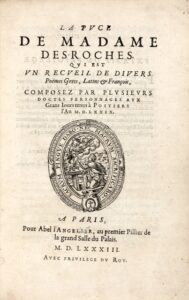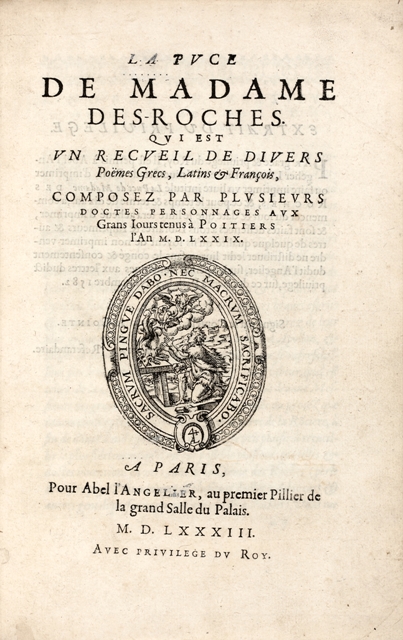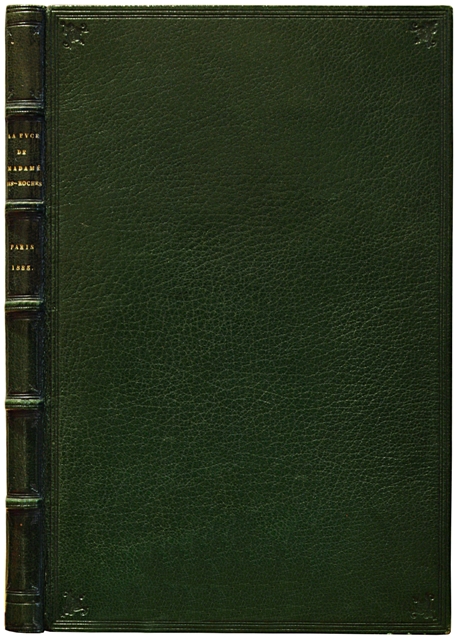A Paris, Pour Abel l’Angelier, 1583. Avec privilège du Roy.
4to [228 x 147 mm] of (4) ll., 94. Full green morocco, triple blind-stamped fillet on the covers, blind-stamped corner fleurons, spine ribbed and blind-stamped decoration, inner border, gilt edges. Binding signed by Koehler towards 1840.
Famous and very rare first edition of “La Puce” by Madame Des Roches, a poetic collection of the 16th century that has always fascinated the arts and deeply interested the American then Canadian universities since the last century. Tchemerzine, II, 910; Bulletin Morgand et Fatout, n°10248.
Madeleine and Catherine Des Roches mother and daughter, both poetesses, were born and lived in Poitiers. Born towards 1530, Madeleine Neveu had had an only daughter from her union with the lord Des Roches, Catherine Fradonnet, who she carefully raised, as it had been done for her, in the love of the arts and poetry. Cultured without pedantry, knowing well the ancient languages, tenderly united one to the other, the mother and daughter held in Poitiers a salon frequented by the fine mind, local or passing through, and which had its hour of glory during the ‘Grands Jours’ in 1579. During one of his visits, Etienne Pasquier, having caught, by change, sight of a flea on the throat of Miss Des Rochers made about the reckless insect a facetious and gallant play in verse, which gave to the other regulars of the salon (Scévole de Sainte-Marthe, Barnabé Brisson, René Chopin, Antoine Loisel, Claude Binet, Nicolas Rapin, Odet de Turnèbe) the idea of composing some about the same topic in French, Italian, Latin and even in Greek.
“The story of the Mme des Roches’ Flea is well known. Several distinguished characters, judges and gentlemen, who were in 1579 in the ‘Grands Jours’ in Poitiers, charmed their leisure hours by working on poetry. These fine minds were one day gathered at Mme des Roches, the Muse of Poitou, when a flea came to rest on her bosom. This little incident gave Estienne Pasquier the opportunity to put into verse a good word. All the assistance copied him and was published, in 1582, a compilation of epigrams, odes, sonnets, &c, whose main merit was to allow a clever praise of Mme des Roches, or of the poets she received. Among the poets who took part in this curious tournament, let’s mention Fr. d’Amboise, Claude Binet, Jean Binet, Jacques Courtin de Cissé, Catherine des Roches, Achille de Harlay, Jacques Mangot, E. Pasquier, Pierre Pithou, Nic. Rapin and Jos. Scaliger. » (De Backer, Auteurs du XVIe siècle, II, 372).
In 1582, an editor, perhaps Pasquier, gathered all these plays by the ‘sing-flea’ poets and published them under the title of La puce de Madame Des Roches. Some copies of the first edition are dated 1582, others 1583.
Hereafter is reproduced the study of the Virginia University about this famous first edition.
“About this edition : The publication of ‘La Puce de Madame des-Roches’ spanned two years, 1582-1583. Most extant editions of the book have a 1583 title page. The copy in the Douglas Gordon Collection is from 1582. In their catalog of the editions of Abel L’Angelier and Françoise de Louvain, Jean Balsamo and Michel Simonin indicate only three copies of the 1582 printing available in other libraries (all in France), compared to eighteen copies from 1583 available in libraries in France, England, and the United States (Abel L’Angelier et Françoise de Louvain (1574-1620), Geneva: Droz, 2002). La Puce de Madame des-Roches collects poems in French, Latin, and several other languages in praise of a flea that had perched on Catherine Des Roches’s breast. In September 1579, a coalition of lawyers and judges from Paris traveled to Poitiers for the Grands Jours. These special court sessions were designed to alleviate courts that were overcrowded with cases from the ongoing civil wars, known as the Wars of Religion. One member of the delegation, the humanist lawyer Estienne Pasquier, promptly paid a visit to Madeleine and Catherine Des Roches. He had heard of the women, whose first book, Les Oeuvres, had been published in Paris the previous year. In a letter to his friend Pierre Pithou, Pasquier described their first meeting this way: as he and Catherine Des Roches talked, he noticed a flea on her breast. He proposed that they each write a poem praising the lucky insect. She agreed, and surprised him with the speed and quality of her response. Their two compositions launched a contest among the salon visitors. Pasquier’s letter and many of the flea poems circulated in manuscript. They were collected and published three years later, in 1582. La Puce de Madame des-Roches captures the jocular spirit of the salon. The poets favor witty wordplays and elaborate anagrams. Many of the poems by men depict the flea exploring Catherine’s imagined body. By extension, the flea encomia also praise the female body. La Puce follows in the tradition of the blasons anatomiques, epigrammatic poems praising individual female body parts. Clément Marot introduced the first blason and launched a poetic competition in the 1530s. The flea contest recalls that earlier one, which Maurice Scève won with his blason of the eyebrow, “Le Sourcil.” Two prefaces open the anthology and reveal the circumstances of the publication of the book […]. The last third of the anthology is made up of poems on topics other than the flea. The title page to the section indicates that the subject of these poems is the Grands Jours, or that they were composed during the court sessions. They include several poems of varying length in Latin, a sonnet cycle in French by Odet de Turnèbe on the ruins at nearby Lusignan, and poems that remind the reader of the judicial context of their composition.”
“This collection, now rare, is one of the most gracious examples of the light poetry in the 16th century. A flea, seen in 1579, during the ‘Grands Jours’, on Mlle Des Roches’ bosom, caused this poetical joust by the finest minds of the time: E. Pasquier, Scévole de Sainte-Marthe, Courtin de Cissé, etc. We can find quite beautiful verses by Madame Catherine Des Roches herself that the editor of this compilation, Jacques de Sourdrai calls ‘la perle de nostre pays poitevin’ (‘the gem of our land’). A lovely play in prose: ‘Louange de la puce’, ends the first part.” (Firmin-Didot, Manuscrits et imprimés, n°316).
Very beautiful copy, wide-margined, bound in morocco by Koehler towards 1840, from Pasquier‘s collection with ex-libris.



